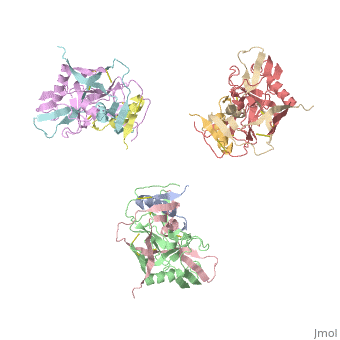Introduction
Human Immunodeficiency Virus (HIV) is a retrovirus/lentivirus that expresses a spike protein on its viral envelope (Env). "The envelope protein is synthesized as a precursor, gp160, which trimerizes and undergoes cleavage into two noncovalently associated fragments, the receptor-binding fragment gp120 and the fusion fragment gp41" [1]. Thus, Env is a heterodimer consisting of gp120 and gp41 and forms trimers on the surface of the viral membrane. The protein structure shown on the right is the gp120 portion of Env in its unbound trimer state [2]. As "the sole antigen on the virion surface," an understanding of Env (gp 120 & 41) and the conformational changes that occur in gp120 and gp41 during binding and fusion, respectively, is necessary in developing new fusion inhibitors and possible vaccines [1] [2].
gp120 Binding
gp120 is responsible for the binding of HIV to CD4 cells. "Binding of gp120 to the primary receptor CD4 and coreceptor (for example, CCR5 and CXCR4) induces large conformational changes, which then trigger dissociation of gp120 and a cascade of refolding events in gp41" [1].

